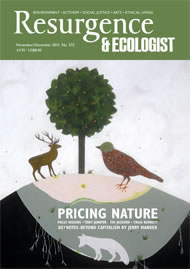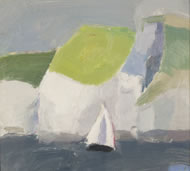Walking along the soft turf of the coastal path at Birsay on Orkney, my attention is caught by a patch of thrift, waving in the onshore breeze. A few flowers on their tough little stems have opened, reaching for the sun, pink petals shading into purple; others are still bundled in tight buds, the overlapping petals making for an intense cerise.
Below, lines of jagged rocks emerge along the foreshore, strata tipped from the horizontal and broken across so the layers of sedimentation are clearly evident. In places the strata are broken vertically, appearing as building blocks ready to hand for Neolithic architects – they who constructed the tomb at Maeshowe and the great stone circles of Brodgar and Stenness. In the valleys between the ridges, boulders of assorted sizes and colours, rounded by the sea, lie tossed into rough heaps.
The sea is retreating with the falling tide. The waves gather in the shallows, break just offshore, roll up the slope of the beach and spill over the broken rocks. White foam pours down, inundating the little inlets and rock pools, then streams back into the sea.
Higher up the foreshore, rock pools are now completely separated from the sea, warming in the thin sunshine. Small children, barefoot, crowd around them, hauling up crabs and other living things in nets, dropping them into their bucket and rushing back to show Mum.
I look back at the thrift. It seems so fragile here, growing in shallow soil, exposed to the wind and the sea and the salt spray. So, I reflect, are the children, with their long limbs and thin bodies, full of life one moment, shivering with cold the next. And so too, in a larger context, is the land of Orkney, old red sandstone exposed to the pounding sea.
For a tiny moment I glimpse the world as forever changing, not fixed in form but endless dance. And then it clicks back into taken-for-granted things in themselves. I am hungry: it is time for lunch.
Is there a connection between the ecological crisis and words about a clump of thrift? As Thomas Berry put it, “We are talking to ourselves. We are not talking to the river, we are not listening to the river. We have broken the great conversation. By breaking the conversation we have shattered the universe.” An adequate response to the ecological crisis is not only about what we must do and stop doing. To recover from ecological disaster, we must also transform our sense of who we are, experience ourselves as part of, rather than apart from, the community of life on Earth. And the challenge is not just to know this intellectually but to feel it intimately, “upon our pulses”, as Keats put it.
All artistic practices can contribute to this shift in identity, including what Granta magazine refers to as “the new nature writing”. In contrast to the older “lyrical pastoral tradition”, which tended to romanticise the natural world and see it as essentially separate from the human, this newer form is more often a narrative that explores the relationship between the writer and the world she encounters. “The new nature writing”, says writer Lydia Peelle, “has got to be couched in stories … where we as humans are present. Not only as observers, but as intrinsic elements.”
Nature writing can take us into a connection with the more-than-human. It can also keep us sane in these troubled times. Thomas Berry suggests that to bear the burden and responsibility of human intelligence we need a world of beauty for the healing it gives. “The greatest, deepest tragedy of losing the splendor of the outer world is that we will always have an inner demand for it.”
In my own writing, I am seeking both to wonder at the minutiae of the world as it unfolds before me and to connect this to the larger patterns and cycles of Gaia. For the great biogeochemical processes of the planet are outside our comprehension unless brought to a human scale. So, as I watch the thrift and the waves, I am taken to experience the fragility of form; picking up a handful of granite granules on St Agnes I am reminded that in the long-term carbon cycle they are participating in life on Earth; or, as in the following, I experience directly the influence of the moon and sun:
It is high tide, springs. The river is full to the brim. The stream no longer pulls Coral against her anchor chain, for the flood has finished. The sun is setting, and I watch the long shadows cast by trees and hedges deepen, and only the high points of the undulating fields catch the light. There is a twittering of birds in the trees, from time to time the caw of a crow. And is that an owl I heard call?
The Earth rolls round, and the sun slowly drops behind the trees by the river. Higher in the sky, the fattened crescent of the waxing moon, three days past new, appears in the darkening sky, Venus shining next to it. “Of course,” I say to myself, “spring tides. Sun and the moon are aligned, pulling the water together.” I have known this in theory for many years, now I see it directly.
Everything is poised, as if waiting for the next move in the rhythm of days and nights, ebb and flow, wind and calm. Coral, too, is waiting, swinging quietly this way then that between wind and the remaining tide. And then, ever so gently, water begins to flow downstream. The pressure on her keel becomes more powerful than the force of the light breeze, and she begins to swing. For just a few moments she catches, broadside across the river as if holding the moment of anticipation, reluctant to commit herself; and finally firmly points her bow upstream. The ebb has begun.
But does the natural world need our writing? Paul Evans, in his Country Diary in The Guardian, wrote of the importance of observing and describing the world with passion; that communicating “the significance of ephemeral and overlooked things to a world which couldn’t care less” is a political and spiritual act. And he follows Rainer Maria Rilke, to tell us we are also giving something back: “The more looked-at world wants to be nourished by love.”








